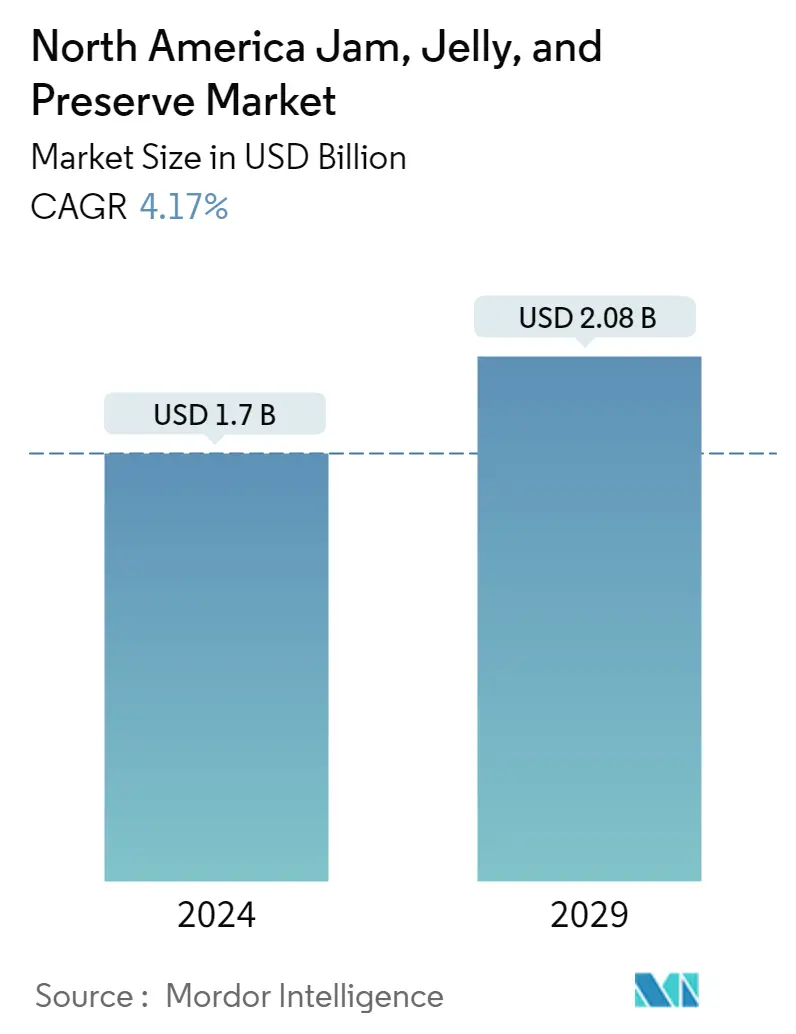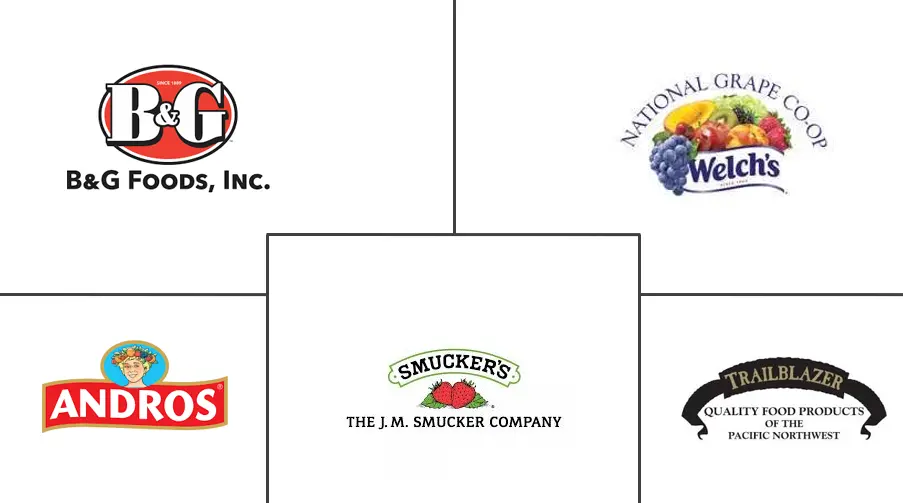Market Size of North America Jam, Jelly, and Preserve Industry

| Study Period | 2019 - 2029 |
| Base Year For Estimation | 2023 |
| Market Size (2024) | USD 1.70 Billion |
| Market Size (2029) | USD 2.08 Billion |
| CAGR (2024 - 2029) | 4.17 % |
| Market Concentration | Low |
Major Players
*Disclaimer: Major Players sorted in no particular order |
North America Jam, Jelly, and Preserve Market Analysis
The North America Jam, Jelly, and Preserve Market size is estimated at USD 1.7 billion in 2024, and is expected to reach USD 2.08 billion by 2029, growing at a CAGR of 4.17% during the forecast period (2024-2029).
The COVID-19 pandemic has disturbed the way the supply chain operates with the jam, jelly, marmalades, and preserves market in odd ways. As the previously ready supply of raw materials like jars, fruits, and sugar, among others, for production has become an unsteady supply. For instance, according to the FAO, the agricultural products that faced a severe hit are cereals, groundnut, castor oils, jams and jellies, sugar, etc., due to international borders canceled flights and disruptions in shipping activity and Canada, which imported CAD 135.045860 million worth jams, fruit jellies, and marmalades in 2019.
In the United States, small companies, like Sqirl, have been experimenting with berries to give their jams a touch of wine flavor. This makes their products stand out in the market, beyond the usual delicacies offered by established brands. Thus, product innovation is one of the key drivers for new brands, which gives tough competition to the existing brands in the spread market.
Most consumers in the developed countries have been looking for food spreads without any inclusion of artificial additives, owing to the associated long-term adverse health effects. Manufacturers are inclined toward the usage of natural flavoring agents, preservatives, and sweeteners, as they are the key ingredients used in sweet spreads to extended the shelf-life of the product. Thus, in 2018, Polaner debuted Polaner Fruit & Maple fruit, and the product is sweetened with golden maple grove farms' pure maple syrup and is available in four flavors: strawberry, raspberry, peach, and blueberry.
North America Jam, Jelly, and Preserve Industry Segmentation
Jam is a thick spread made from fruit juice, chopped, crushed, or puréed fruit, and sugar. Preserves are another thick fruit spread made from fruit cooked with sugar, but in this case, large pieces of the fruit, or the whole fruit (as in the case of berries), are suspended in a firm jelly or less-gelled syrupy base. The North American jam, jelly, and preserve market is segmented into product type, distribution channel, and geography. By product type, the market studied is segmented into jam and jellies, marmalade, and preserves. By distribution channel, the market studied is segmented into supermarkets/hypermarkets, convenience stores, online stores, and other distribution channels. By geography, the market studied has been segmented into the United States, Canada, Mexico, and Rest of North America. For each segment, the market sizing and forecasts have been done on the basis of value (in USD million).
| By Type | |
| Jam and Jellies | |
| Marmalades | |
| Preserves |
| By Distribution Channel | |
| Supermarkets/Hypermarkets | |
| Convenience Stores | |
| Online Stores | |
| Other Distribution Channels |
| By Geography | |
| United States | |
| Canada | |
| Mexico | |
| Rest of North America |
North America Jam, Jelly, and Preserve Market Size Summary
The North American jam, jelly, and preserve market is experiencing a dynamic phase characterized by both challenges and opportunities. The market is poised for growth, driven by evolving consumer preferences and innovative product offerings. The COVID-19 pandemic disrupted supply chains, affecting the availability of raw materials like fruits and sugar, which are crucial for production. This disruption has led to a shift in focus towards product innovation, with smaller companies experimenting with unique flavors to differentiate their products from established brands. Consumers in developed countries are increasingly seeking food spreads free from artificial additives, prompting manufacturers to adopt natural ingredients to meet this demand. This trend is creating opportunities for brands to introduce high-quality products with clean labels, aiming to enhance sustainability and taste.
The competitive landscape of the North American jam, jelly, and preserve market is marked by the presence of both local and international players, with significant market share held by companies like The J.M. Smucker Company, B&G Foods Inc., and National Grape Cooperative Association Inc. The market is witnessing a rise in country-specific local brands offering competitive pricing, which is intensifying price competition and encouraging established brands to innovate. The preference for breakfast spreads among American consumers is driving demand, with a notable increase in private-label brands contributing to market competition. International brands with specialized offerings continue to dominate, while companies like Crofters and Andros Group are expanding their product lines to capture the growing organic segment. The market's growth trajectory is supported by strategic expansions and product launches aimed at enhancing production capacity and meeting consumer demands.
North America Jam, Jelly, and Preserve Market Size - Table of Contents
-
1. MARKET DYNAMICS
-
1.1 Market Drivers
-
1.2 Market Restraints
-
1.3 Porter's Five Forces Analysis
-
1.3.1 Threat of New Entrants
-
1.3.2 Bargaining Power of Buyers/Consumers
-
1.3.3 Bargaining Power of Suppliers
-
1.3.4 Threat of Substitute Products
-
1.3.5 Intensity of Competitive Rivalry
-
-
-
2. MARKET SEGMENTATION
-
2.1 By Type
-
2.1.1 Jam and Jellies
-
2.1.2 Marmalades
-
2.1.3 Preserves
-
-
2.2 By Distribution Channel
-
2.2.1 Supermarkets/Hypermarkets
-
2.2.2 Convenience Stores
-
2.2.3 Online Stores
-
2.2.4 Other Distribution Channels
-
-
2.3 By Geography
-
2.3.1 United States
-
2.3.2 Canada
-
2.3.3 Mexico
-
2.3.4 Rest of North America
-
-
North America Jam, Jelly, and Preserve Market Size FAQs
How big is the North America Jam, Jelly, and Preserve Market?
The North America Jam, Jelly, and Preserve Market size is expected to reach USD 1.70 billion in 2024 and grow at a CAGR of 4.17% to reach USD 2.08 billion by 2029.
What is the current North America Jam, Jelly, and Preserve Market size?
In 2024, the North America Jam, Jelly, and Preserve Market size is expected to reach USD 1.70 billion.

